The FUE Hair Transplant method is the most used and updated technique in the world. In the Fue technique, patients get a more frequent and more natural result. The hair is taken one by one with special-tipped micro motors (0.7-0.8.5mm), and planted in the balding areas determined during the drawing stage, in a dense and natural way, based on the direction of hair growth.
FUE Hair Transplant Technique
FUE (Follicular Unit Extraction) is the most preferred method in hair transplantation today, the most practical in terms of application, and the highest success rate. As Medical of Istanbul, we prefer this method, which is the most used in the world, does not require any surgical procedure, does not leave a permanent scar and is performed painlessly.
Hair transplantation with the FUE method is carried out by transplanting the hair follicles taken one by one from the point of the body where the hair grows in a healthy way (this is called the donor area; generally the nape between the two ears is preferred) to the area to be transplanted one by one. In this method, which is applied under local anesthesia, special devices called micro motors are used. The FUE method, which is much more effective compared to the old methods, in which the hair follicles are removed in strips and leave permanent scars on the patient, can be applied with or without shaving, depending on the condition of hair loss in the patient.
After the hair transplantation procedure performed with the FUE technique, the process of complete healing of the transplantation area and the completion of new hair formation takes 9-12 months in total. Watch FUE Technique at our Youtube Chanel
FUE Technique Hair Transplant and Stages
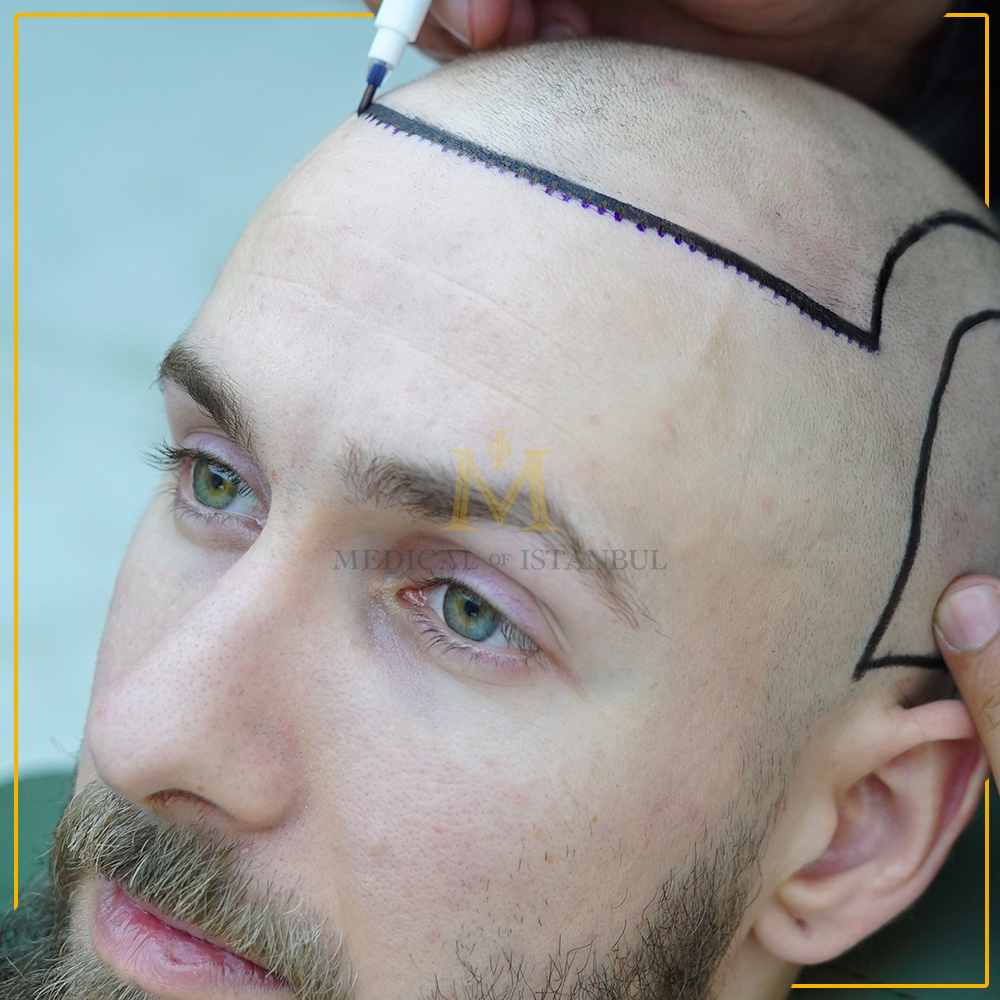
1) Hairline Determination
The stage of determining the hairline is one of the most important stages for patients. Because patients will use the determined hairline for life. The most important factor in determining the hairline is the baldness area and facial muscle line. To determine the natural hairline, we find the muscle ending point on the forehead by moving the patient’s eyebrows upwards. The hairline is determined from the end point of the forehead muscles and according to the patients’ request.
2) Hair Cut
After the hairline is determined, the hair in the balding area and the donor area is cut.
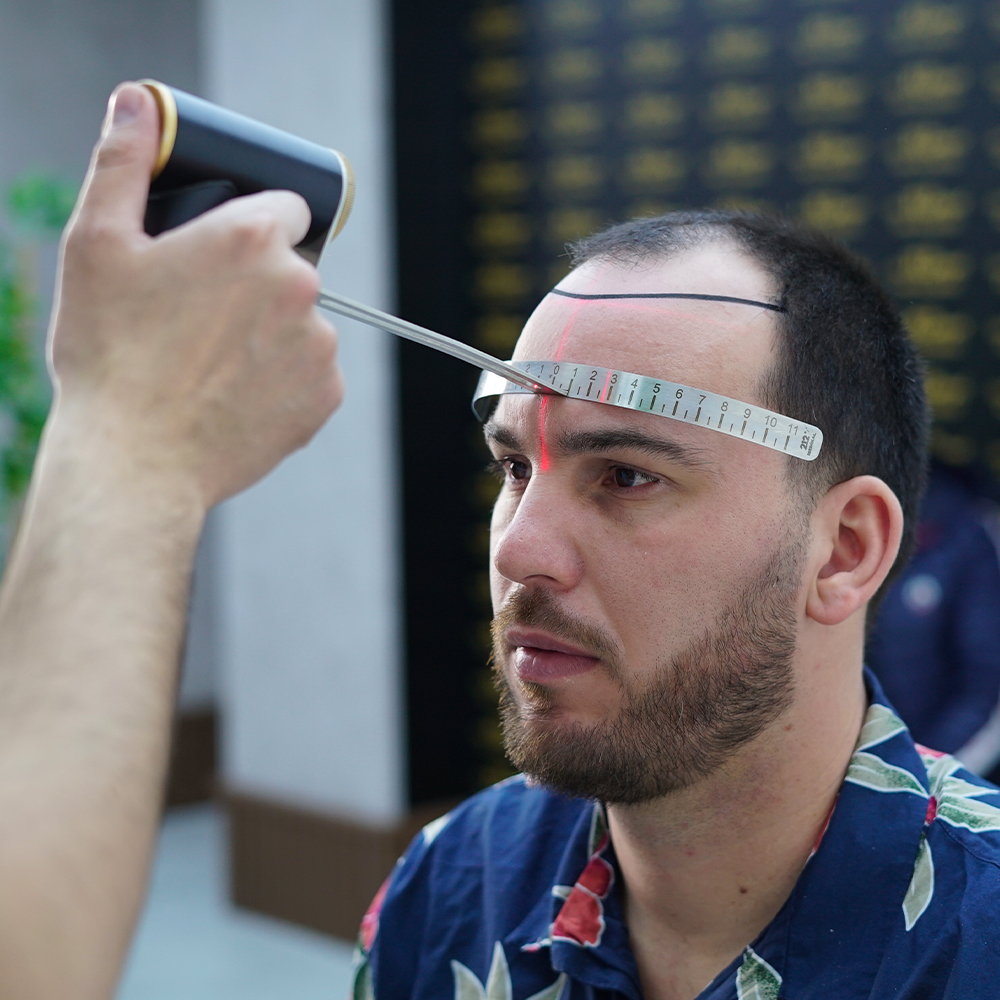

3) Determination of The Donor Area
Before the operation, the area where the hair will be taken is analyzed and the donor area is determined according to the shedding limits in the area between the two ears. Hair is not taken from places where the hair is sparse in the donor (between two ears) area.
4) Local Anesthesia
Before starting the operation, local anesthesia is applied painlessly with minimal needles to the area where the hair will be taken (donor area). Local anesthesia ensures that the patient does not feel pain during the operation and has a comfortable operation.

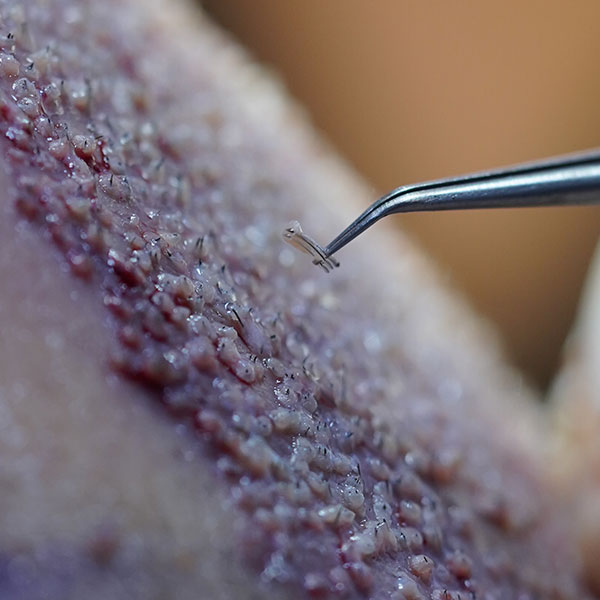
5) Hair Collection
The donor area will be used as the area where the hair follicles will be collected for the transplantation process. Hair is taken from the donor area homogeneously with micro motors. The homogeneous collection of hair provides a natural and scar-free appearance in the donor area. There are 1 to 5 hair strands in one hair follicle.
6) Channel Openning
Channel openning is done using sterile slit or Sapphire. Depending on the quality of the roots (length, thickness and texture), channels are opened. In this process, the canal is opened frequently so that no other root can enter between the two roots.
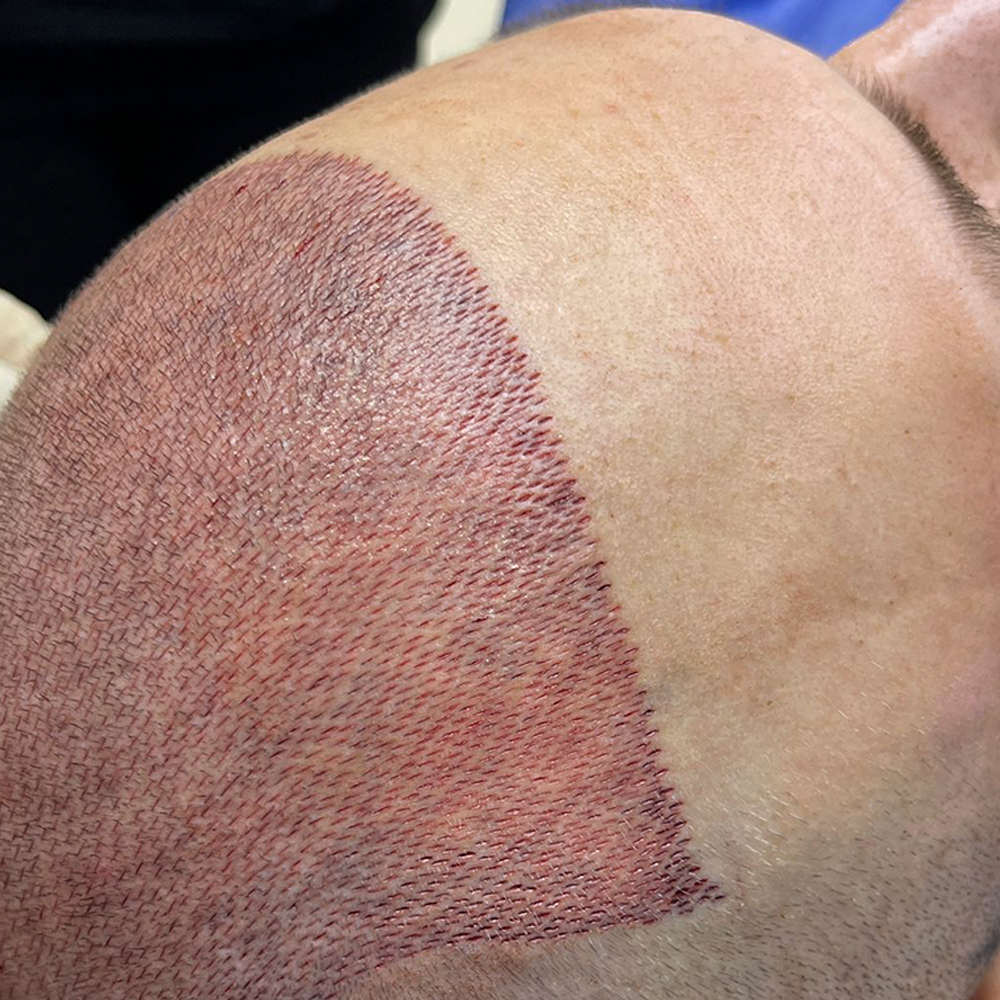
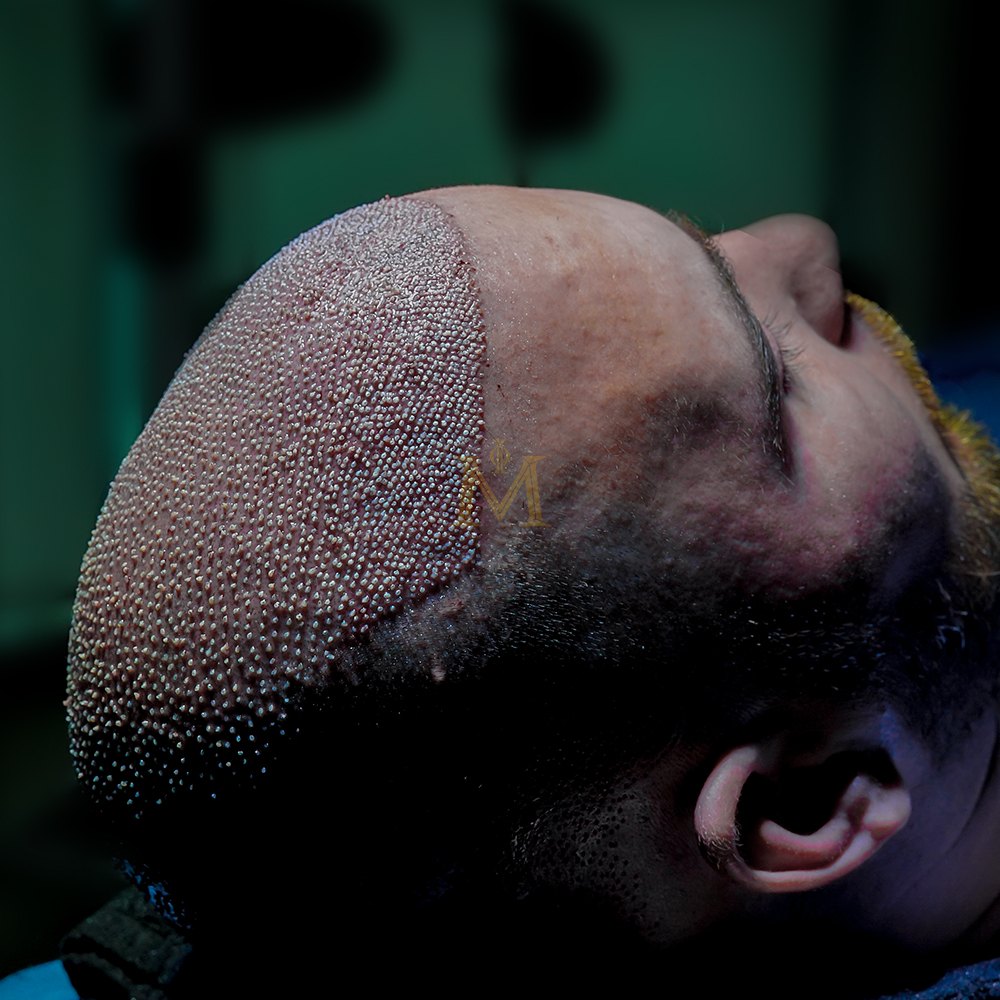
7) Hair Transplant
Hair transplantation is planned before the operation begins. Single hair follicles are planted in the front rows to achieve a natural look. Multiple hair follicles are transplanted starting from the back of the front area to create natural density. In hair transplantation, an intensive hair transplantation process takes place due to the high blood circulation in the anterior region of our head.
Advantages of FUE Technique
- In the Feu method, there is no scar in the donor area. Since homogeneous hair removal is performed, a natural appearance is provided in the donor area.
- Since the recovery is faster with the FUE method, patients can return to their normal lives in a shorter time.
- If the roots are not damaged in the Fue method, the success rate is 98%.
- Hair transplant is easier.
- The latest technologies that are updated every day are used.
- If the collected hair follicles are healthy, hair transplantation is done as much as desired.
- A more intense, dense and natural result is obtained.
After Feu Hair Transplantation Care and Recovery Process
In the process after hair transplantation, it is of great importance for the patient to comply with the rules determined by the doctor and to regulate his lifestyle accordingly, as a matter that directly affects the success of the hair transplantation operation. The post-hair transplant process, which should be followed carefully in an average of 6 months; It is necessary to continue follow-up in daily, weekly and monthly periods.
First 3 Days
For the first 3 days, which is the most critical period after hair transplantation, it is recommended that the patient rest at home, mostly lying on his back. Pain that may occur in the first 2-3 days after the effect of local anesthesia applied during hair transplantation is relieved with the help of painkillers taken under the control of a doctor. The hair transplant area should never be contacted with water and chemicals. At the end of 3 days, the patient can wash the hair for the first time under the doctor’s control. During the recovery period, the patient should wash their hair as recommended by the doctor in the first wash and use only shampoo, serum and similar care products given by the doctor.
First Week
In the first week, the patient should avoid situations such as heavy work, stress, sports, extreme excitement, sexual intercourse, smoking and alcohol use that will increase blood circulation; should protect the head against any trauma and should not use accessories such as hats and berets. In order to facilitate the rapid crusting of the hair transplanted area, the bandage is not put on and the hair transplant area is left open. This crusting situation disappears completely a few days after the procedure in the donor area, and the crusting that occurs in the transplantation area lasts for about a week. In the first week of the healing process, crusting in the planting area creates a slightly injured appearance. This appearance disappears as the crusts begin to fall off in a 10-15 day period.
First 1 Month
Generally, the time interval starting from the second week of the hair transplant operation and extending to the end of the third month is the shedding process of the transplanted hair. In this period, which is called shock shedding, it is expected that most of the hair follicles will be shed in the first month, and the rest at certain intervals in a 6-month period depending on the patient’s body. Since the skin will still be in a sensitive structure in this process, the patient should stay away from strenuous activities such as jogging, exercise, and wet areas such as pools and the sea. In this period, the patient should not scratch the area in the face of itching that may occur in the planting area.
First 3 Months
After the hair follicles shed in the first month, new hair starts to grow slowly at the end of 3 months. During this period, hair follicle strengthening applications such as hair Vitamin, mesotherapy and PRP can be performed.
From the beginning of hair growth to about 6 months, the hair reaches its natural length. The remaining part of the hair follicles, which grow at a rate of 70% in 6 months, continues to grow in a healthy way for 1 year.
Risks of Fue Hair Transplantation
Like other operations, there may be side effects and problems in hair transplantation. After these operations, there may be traumatic scars and swellings on the scalp. These problems are usually temporary and short-lived. Side effects that can be seen after hair transplantation;
- Swelling and bruising under the eyes
- Scars in the transplant area and donor area
- Post-operative blood leakage
- Infection
- Numbness in the anesthetized areas
- Loss of transplanted hair (shock loss)
All these side effects are temporary. So you don’t have to be afraid or worried. The most risky situation that can occur is infection. This is treated quickly with the early intervention of our team and the hair grows naturally in that area without any problems.
Unshaven Hair Transplant
Unshaven hair transplantation is applied to areas with partial shedding or partial sparseness in the front line, in the crown area or in a certain area of the upper part of the head, without cutting the hair completely. Only the area where the hair is taken is shaved. The area to be transplanted is usually not shaved.

